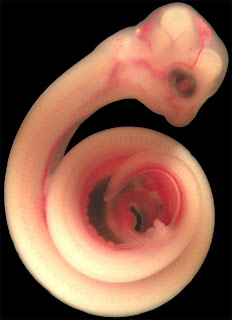úterý 8. června 2010

HORSE EMBRYO
The gestation period lasts for about eleven months, or about 340 days (normal average range 320–370 days). During the early days of pregnancy, the conceptus is mobile, moving about in the uterus until about day 16 when "fixation" occurs. Shortly after fixation, the embryo proper (so called up to about 35 days) will become visible on trans-rectal ultrasound (about day 21) and a heartbeat should be visible by about day 23. After the formation of the endometrial cups and early placentation is initiated (35–40 days of gestation) the terminology changes, and the embryo is referred to as a fetus. True implantation - invasion into the endometrium of any sort - does not occur until about day 35 of pregnancy with the formation of the endometrial cups, and true placentation (formation of the placenta) is not initiated until about day 40-45 and not completed until about 140 days of pregnancy. The fetus gender can be determined by day 70 of the gestation using ultrasound. Halfway through gestation the fetus is the size of between a rabbit and a beagle. The most dramatic fetal development occurs in the last 3 months of pregnancy when 60% of fetal growth occurs.

KANGAROO EMBRYO
Kangaroo reproduction is similar to that of opossums. The egg (still contained in the evolutionary remnant of a shell, a few micrometres thick, and with only a small quantity of yolk within it) descends from the ovary into the uterus. There it is fertilised and quickly develops into a neonate. Even in the largest kangaroo (the red kangaroo) the neonate emerges after only 33 days. Usually only one young is born at a time. It is blind, hairless and only a few centimetres long; its hind legs are mere stumps; it instead uses its more developed forelegs to climb its way through the thick fur on its mother's abdomen into the pouch, which takes about three to five minutes. Once in the pouch, it fastens onto one of the two teats and starts to feed. Almost immediately, the mother's sexual cycle starts again. Another egg descends into the uterus and she becomes sexually receptive.

DOLPHIN EMBRYO
The gestation period varies per species; for the small Tucuxi dolphin, this period is around 11 to 12 months, while for the Orca the gestation period is around 17 months. They usually become sexually active at a young age, even before reaching sexual maturity. The age of sexual maturity varies by species and gender.

CAT and LION EMBRYO
The gestation period for cats is between 64–67 days, with an average length of 66 days. The size of a litter averages three to five kittens, with the first litter usually smaller than subsequent litters.
The average gestation period is around 110 days, the female giving birth to a litter of one to four cubs in a secluded den (which may be a thicket, a reed-bed, a cave or some other sheltered area) usually away from the rest of the pride.

CHIMPANZEE EMBRYO
Chimpanzees are members of the Hominidae family, along with gorillas, humans, and orangutans. Chimpanzees split from human evolution about 6 million years ago and the two chimpanzee species are the closest living relatives to humans, all being members of the Hominini tribe (along with extinct species of Hominina subtribe). Chimpanzees are the only known members of the Panina subtribe. The two Pan species split only about one million years ago. Females give birth every 4 to 5 years and their gestation period is 8 to 9 months.

ELEPHANT EMBRYO
Elephants are the largest land animals now living. The elephant's gestation period is 22 months, the longest of any land animal. At birth it is common for an elephant calf to weigh 120 kilograms (260 lb). They typically live for 50 to 70 years, but the oldest recorded elephant lived for 82 years.
Přihlásit se k odběru:
Komentáře (Atom)






